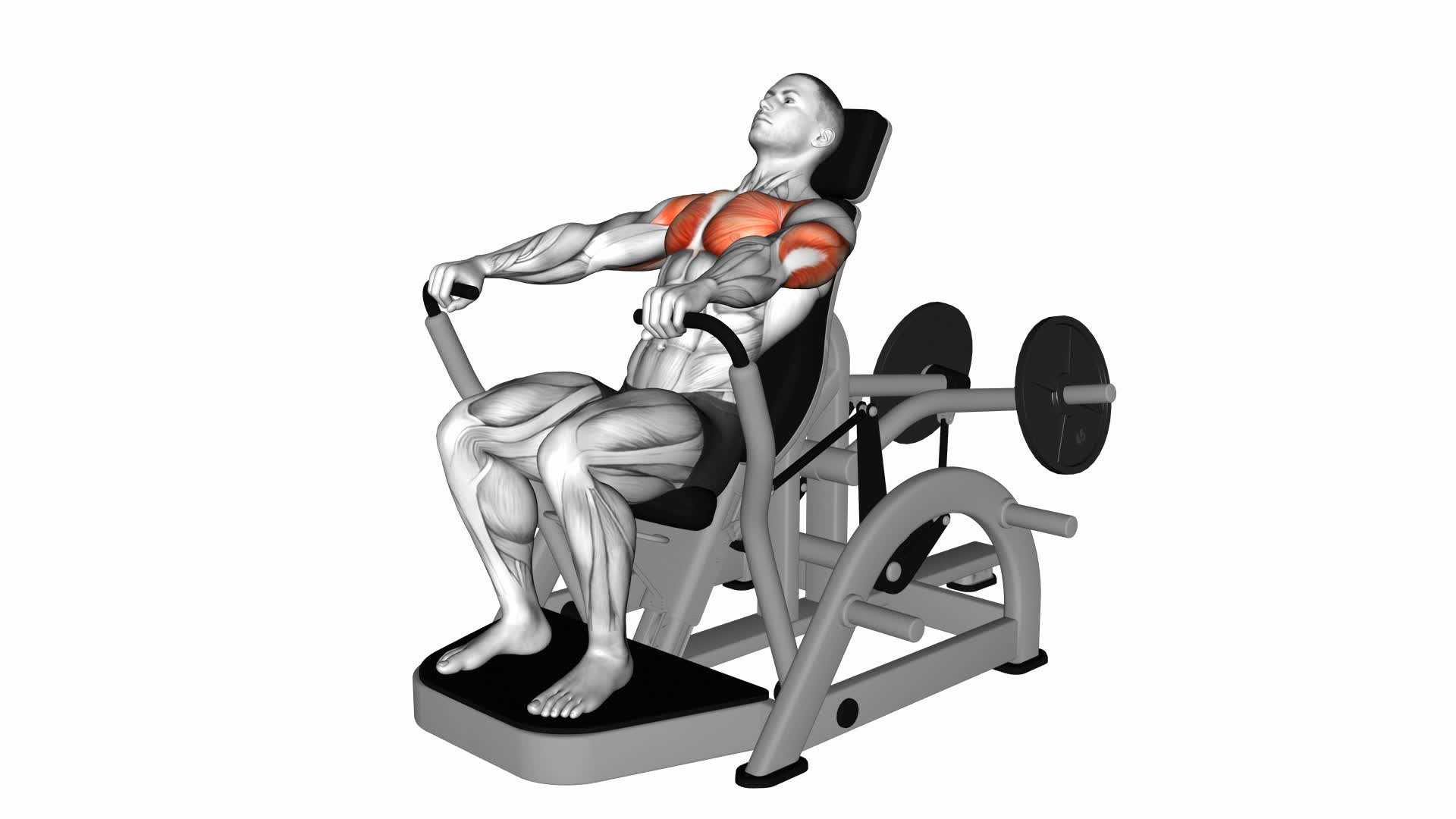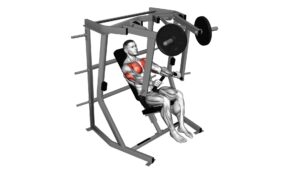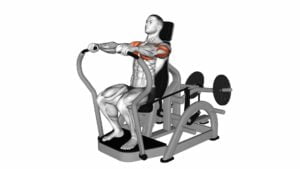Lever Decline Chest Press (VERSION 2) – Video Exercise Guide & Tips

Are you looking to strengthen and sculpt your chest muscles? Look no further than the Lever Decline Chest Press (Version 2)!
Watch This Exercise Video
In this video exercise guide, we'll show you the proper form and technique to maximize your results. With variations and modifications available, you can tailor this exercise to your fitness level.
Avoid common mistakes, increase intensity, and progress towards your goals with our helpful tips.
Let's get started and achieve that strong, chiseled chest you've been working for!
Key Takeaways
- The lever decline chest press engages more muscle fibers in the chest due to its greater range of motion.
- It puts less stress on the shoulders and joints compared to the barbell bench press, making it suitable for individuals with shoulder or joint issues.
- The exercise targets the lower portion of the chest, helping to develop a well-rounded and defined chest.
- It allows for constant resistance throughout the movement, effectively building upper body strength.
Benefits of the Lever Decline Chest Press
The Lever Decline Chest Press offers several advantages and is known for its effectiveness in targeting the chest muscles.
One of the main benefits of this exercise is that it allows for a greater range of motion compared to traditional chest press exercises. This increased range of motion helps to engage more muscle fibers in the chest, leading to greater muscle activation and development.
Another advantage of the Lever Decline Chest Press is that it places less stress on the shoulders and joints compared to exercises like the barbell bench press. This makes it a safer option for individuals with shoulder or joint issues. Additionally, the decline angle of the exercise targets the lower portion of the chest, helping to develop a well-rounded and defined chest.
The Lever Decline Chest Press is also an effective exercise for building upper body strength. By using a lever rather than free weights, this exercise provides a constant resistance throughout the entire movement, resulting in improved strength gains.
Equipment and Setup for the Exercise
To properly set up for the Lever Decline Chest Press, you'll need an adjustable bench that allows you to decline the angle. Make sure the bench is sturdy and secure before starting your exercise.
Additionally, choose a weight that challenges you but still allows you to maintain proper form throughout the movement.
Adjustable Bench Options
To properly set up for the Lever Decline Chest Press exercise, you'll need an adjustable bench. An adjustable bench offers various benefits for the decline bench press, including allowing you to target your lower chest muscles more effectively.
Here are two key factors to consider when positioning your bench:
- Angle Adjustment: Ensure that your adjustable bench is set to a decline position, typically between 15 to 30 degrees. This angle helps engage your lower chest muscles and increases the range of motion during the exercise.
- Height Adjustment: Set the height of the bench so that your feet are firmly planted on the ground. This ensures stability and allows you to generate more power from your lower body during the exercise.
Proper Weight Selection
To ensure proper weight selection for the Lever Decline Chest Press exercise, you should start by adjusting the weight stack on the lever machine. This will allow you to choose a weight that challenges you without sacrificing proper form.
One common mistake is selecting a weight that's too heavy, leading to poor technique and increased risk of injury. On the other hand, choosing a weight that's too light won't effectively engage your chest muscles and limit the intensity of the exercise.
To increase intensity, gradually increase the weight as you become stronger and more comfortable with the exercise. It's important to listen to your body and make adjustments accordingly, finding a weight that allows you to complete the desired number of repetitions with proper form.
Proper Form and Technique
Ensure that you maintain proper form and technique while performing the Lever Decline Chest Press exercise. This won't only maximize the effectiveness of the exercise but also reduce the risk of injury.
Here are some important tips to help you maintain proper form and technique:
- Common Mistakes:
- Arching your back: Avoid arching your back excessively as this can strain your lower back. Keep your back flat against the bench throughout the exercise.
- Flaring your elbows: Keep your elbows close to your body to target your chest muscles effectively. Flaring your elbows outward can shift the focus to your shoulders and increase the risk of injury.
Tips for Progression:
- Start with lighter weights: It's important to start with a weight that you can comfortably handle while maintaining proper form. Gradually increase the weight as you become stronger and more comfortable with the exercise.
- Focus on controlled movements: Slowly lower the weight down and push it back up in a controlled manner. This won't only engage your chest muscles more effectively but also reduce the risk of muscle imbalances and injuries.
Variations and Modifications
Now let's explore the different variations and modifications you can incorporate into your lever decline chest press routine. Making modifications to your exercises can have several benefits, such as targeting specific muscle groups or accommodating for injuries or limitations.
Some popular variation options include adjusting the angle of the decline bench, using different grip positions, or incorporating resistance bands.
However, it's essential to consider safety when making modifications, ensuring proper form and technique to prevent injury.
Benefits of Modifications
Explore the advantages of making modifications to your Lever Decline Chest Press exercise for enhanced results.
- Increased Muscle Activation: By modifying the exercise, you can target specific muscles more effectively, leading to better overall muscle development. For example, adjusting the grip width can shift the emphasis from the chest to the triceps or shoulders.
- Injury Prevention: Modifications can help alleviate strain on vulnerable areas, reducing the risk of injury. For instance, individuals with shoulder issues can opt for a neutral grip or use resistance bands instead of weights to minimize stress on the joints.
- *Joint-Friendly Options*: Incorporating modifications like using a stability ball or performing the exercise on an incline bench can reduce stress on the shoulders and wrists while still engaging the chest muscles.
- *Progression and Regression*: Modifications also allow for progression or regression of the exercise, making it suitable for individuals of different fitness levels. Adjusting the weight, angle, or range of motion can help challenge or accommodate varying strength levels.
Popular Variation Options
To enhance your Lever Decline Chest Press exercise, consider popular variation options and modifications.
There are several decline chest press variations that you can incorporate into your workout routine to target different muscles and add variety to your training.
One popular variation is the decline dumbbell chest press, which allows for a greater range of motion and activates more stabilizer muscles.
Another option is the decline cable chest press, which provides constant tension throughout the movement and targets the chest from different angles.
Additionally, the decline Smith machine chest press offers the advantage of a fixed barbell, providing more stability and control.
By incorporating these variations, you can reap the benefits of different chest press exercises and challenge your muscles in new ways.
Transitioning into the subsequent section about safety considerations for modifications, it's important to keep in mind proper form and technique to prevent injuries.
Safety Considerations for Modifications
For optimal safety when incorporating variations and modifications of the Lever Decline Chest Press, be mindful of proper form and technique to prevent injuries. Here are some safety precautions to consider:
- Start with a proper warm-up: Prior to attempting any modifications or variations of the Lever Decline Chest Press, it's important to warm up your muscles and joints. This helps increase blood flow and flexibility, reducing the risk of injury.
- Gradually progress: If you're new to the Lever Decline Chest Press or trying a new modification, start with lighter weights and gradually increase the load. This allows your muscles to adapt and reduces the chance of straining or pulling a muscle.
Common Mistakes to Avoid
Avoid rushing through the lever decline chest press exercise as it can lead to poor form and potential injury. To perform the exercise correctly and get the most out of it, it's important to be aware of common mistakes and focus on maintaining proper form.
One common mistake to avoid is using too much weight. It may be tempting to lift heavy weights, but using excessive weight can compromise your form and increase the risk of injury. Start with a weight that challenges you but allows you to maintain proper technique throughout the exercise.
Another mistake is arching your back excessively. This can put unnecessary strain on your lower back and take the focus away from your chest muscles. Keep your back flat against the bench and engage your core to maintain stability during the exercise.
Improper hand placement is another common mistake. Your hands should be positioned slightly wider than shoulder-width apart, with your elbows pointing outwards. This allows for proper engagement of the chest muscles and reduces the strain on your shoulders.
Lastly, avoid locking out your elbows at the top of the movement. This can lead to joint stress and decrease the effectiveness of the exercise. Instead, maintain a slight bend in your elbows throughout the movement to keep tension on your chest muscles.
Tips for Increasing Intensity and Progression
Increase the intensity and progression of your lever decline chest press by gradually increasing the weight and adding more challenging variations to the exercise. Here are some tips to help you achieve this:
- Increasing Resistance:
- Start by selecting a weight that's challenging but allows you to maintain proper form.
- As you become stronger, progressively increase the weight in small increments.
- Aim to reach a point where you can comfortably perform 8-12 repetitions with the added resistance.
- Remember to always prioritize maintaining proper form over lifting heavier weights.
- Advanced Modifications:
- Once you have mastered the basic lever decline chest press, you can introduce advanced variations to further challenge your muscles.
- One option is to perform a single-arm lever decline chest press, which requires greater stability and engages more core muscles.
- Another modification is to incorporate a pause at the bottom of each repetition, allowing for increased time under tension and further muscle activation.
- You can also try using resistance bands or chains to vary the resistance throughout the exercise.
Frequently Asked Questions
How Many Sets and Reps Should I Perform for the Lever Decline Chest Press?
To determine the number of sets and reps for the lever decline chest press, consider your fitness goals and current workout routine. Generally, you can start with 3-4 sets of 8-12 reps. However, it's important to listen to your body and adjust accordingly.
If you're looking for chest press variations, you can try incline or flat bench presses, push-ups, or dumbbell chest presses. These alternative chest exercises can help target different areas of your chest muscles.
Can I Substitute the Decline Bench With a Regular Flat Bench for This Exercise?
Yes, you can substitute the decline bench with a regular flat bench for the lever decline chest press. However, using a decline bench offers unique benefits for chest exercises.
It targets the lower pecs more effectively, helps increase muscle activation, and can provide a greater range of motion.
To perform the lever decline chest press with proper form and technique, ensure your back is firmly against the bench, engage your core, and maintain a controlled and steady movement throughout the exercise.
Is the Lever Decline Chest Press Suitable for Beginners?
Yes, the lever decline chest press is suitable for beginners. If you're just starting out, it's important to build a solid foundation before progressing to more advanced exercises. However, if you find the decline bench too challenging, there are alternative chest exercises for beginners that can still help you strengthen your chest muscles.
Incorporating decline exercises in your workout routine can provide additional benefits, such as targeting the lower chest and increasing overall muscle activation.
Can I Use Dumbbells Instead of a Lever Machine for This Exercise?
Yes, you can definitely use dumbbells instead of a lever machine for the dumbbell variation of the decline chest press exercise. However, it's worth mentioning that using a lever machine offers unique benefits.
The lever machine provides a controlled range of motion, which can help with stability and target specific muscles in your chest. Additionally, the lever machine allows you to adjust the resistance easily, making it suitable for beginners and advanced users alike.
How Often Should I Include the Lever Decline Chest Press in My Chest Workout Routine?
To properly perform the lever decline chest press, position yourself on the decline bench and grasp the handles. Lower the lever until your elbows are at a 90-degree angle, then push the handles forward to fully extend your arms.
Incorporating this exercise into your chest workout routine can help target your lower chest muscles and increase overall chest strength. Aim to include the lever decline chest press 1-2 times per week for optimal results.
Conclusion
In conclusion, the Lever Decline Chest Press is a highly effective exercise for targeting the chest muscles.
With the proper equipment and setup, along with correct form and technique, this exercise can help to strengthen and tone the chest.
Variations and modifications can be made to suit individual fitness levels, and it's important to avoid common mistakes to maximize results.
By following these tips and gradually increasing intensity, progress can be achieved in chest strength and overall fitness.

Author
Years ago, the spark of my life’s passion ignited in my mind the moment I stepped into the local gym for the first time. The inaugural bead of perspiration, the initial endeavor, the very first surge of endorphins, and a sense of pride that washed over me post-workout marked the beginning of my deep-seated interest in strength sports, fitness, and sports nutrition. This very curiosity blossomed rapidly into a profound fascination, propelling me to earn a Master’s degree in Physical Education from the Academy of Physical Education in Krakow, followed by a Sports Manager diploma from the Jagiellonian University. My journey of growth led me to gain more specialized qualifications, such as being a certified personal trainer with a focus on sports dietetics, a lifeguard, and an instructor for wellness and corrective gymnastics. Theoretical knowledge paired seamlessly with practical experience, reinforcing my belief that the transformation of individuals under my guidance was also a reflection of my personal growth. This belief holds true even today. Each day, I strive to push the boundaries and explore new realms. These realms gently elevate me to greater heights. The unique combination of passion for my field and the continuous quest for growth fuels my drive to break new ground.







